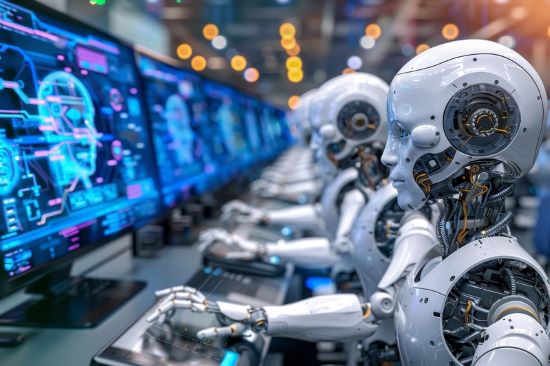World population will peak in the mid-2080s states the latest United Nations report. Today it is 8.2 billion. At peak, it will hit 10.3. Billions of young people may face underemployment as jobs become redundant because of technological innovation, namely a confluence of robotics and artificial intelligence (AI).
Depending on technology to solve every working problem is fraught with hazards. More people are being added to the planet daily mostly in the countries of the Global South. Meanwhile, millions of job vacancies are posted in the Global North on Internet sites seeking workers. Why are we hell-bent on implementing automation for almost every type of work humans have done until now without considering the distribution of global human assets? What’s the rush to replace humans using robots and AI?
Besides machine automation it is the software….“there’s the rub.” In Shakespeare’s Hamlet, Act 3, Scene 1, in the famous “to be or not to be” speech, Shakespeare used the word rub to mean harm. In today’s automating world there seems to be a great deal of rub happening. It’s not just robots and AI software that are the villains, but our addiction to screens as well that is turning humanity into an enabler of its demise.
I’m no Luddite, a term that refers to a 19th-century labour movement in the United Kingdom that opposed automating the textile industry. When I woke up yesterday to news headlines about a software patch disrupting business operations across the planet, I almost wanted to become a Luddite as I surveyed just how far down the path to human insignificance we are treading.
The crash of systems across the world yesterday was not malware or a cyberattack. Its cause was a minor and routine security software update being deployed on Microsoft Internet servers. Somehow, the update contained bad code which turned into a technological mugging of New York City’s subways, major U.S. airlines, hospitals across the world and even my local grocery store where a single cash register was the only one still available.
Technology Dependency Has A Downside
I have grown up in the age of computing. I remember the prequel when mainframes were dominant. Coders learned languages like Fortran, Cobol and PL1. Those coders are long retired and their replacements are learning languages like C++ and C# which have no relevance for mainframe systems that remain the linchpin of financial, academic and government information technology infrastructure.
In many cases, there are no operating manuals for a new generation of programmers to refer to when trying to maintain these systems. Back in the day when I worked on systems documentation, describing what the software did or was supposed to do was important. A required prerequisite was to document processes before software implementations just in case the latter crashed. By maintaining manual legacy processes it meant businesses, utilities, hospitals and governments could still operate in the event of a software crash. Somewhere in the evolution of computing systems and software, however, those paper processes and the employees who used them have long vanished. Hence, yesterday, thousands of flights got cancelled, critical hospital surgical procedures were postponed, and travellers on public transit found themselves marooned. All of this was because of a software patch screw-up.
Today manufacturers, warehousing and logistic operations are automating using robots to take over the work formerly done by people. These businesses are becoming more technology-dependent. AI is being integrated into robotic subroutines or being deployed in computer networks that are the nerve centre of these businesses. That means there is less of a need for human intelligence to do the day-to-day work.
Back in 2020, a headline on the BBC website declared “Machines to ‘do half of all work tasks by 2025.'” This statement preceded the advent of AI Large Language Models (LLMs) which today are being deployed in all kinds of businesses. The facts backing the article’s argument came from polling executives in 300 of the world’s biggest companies whose compiled responses produced a report concluding that 97 million jobs would be added because of robotics while almost as many human jobs would disappear. This was particularly true for routine manual work processes. The article called it a “double disruption” and a hurdle for workers to overcome, arguing that businesses and government would need to retrain millions and deploy stronger safety nets for humans displaced by machines.
Did the BBC article get it right? We are not at the point of seeing robots take over 50% of business operations in 2024. But by the mid-2030s, at the present rate of AI deployment, we may see it cause the shedding of millions of jobs.
The Impact Of AI On Human Jobs
It’s not like work won’t need to be done. It just won’t be done by people. A recent Goldman Sachs report describes AI replacing 300 million full-time jobs, 46% administrative, 44% in the legal profession, 6% in the construction industry, and 4% in maintenance. AI software will replace human middle managers in finance and banking, media and marketing, and legal services.
The World Economic Forum (WEF) recently noted that U.S. banking and financial institutions are using AI to monitor 56% of banking transactions and 52% claim they are using the technology to generate revenue including providing customers with financial advice. The WEF also predicted that China’s financial sector will by 2027 shed 23% of its jobs using AI tools instead.
Another disruption will be news being written by machines. LLMs will write the stories that previously were composed by human reporters. News from businesses marketing their goods and services to the world will most certainly be AI-written. The shock to those earning a livelihood in marketing communications is only just beginning.
AI will write legal briefs impacting paralegal workers and junior lawyers. AI bots will democratize legal aid by giving people tools that provide legal help services without pricey hourly fees. A 2023 article in Fortune, cites Andrew Perlman, Dean of Suffolk University Law School that today low-income earners in the U.S. get very little to no legal help for 92% of civil legal problems. AI LLMs will reverse that percentile to the detriment of legal profession jobs.
Robot Impacts On Human Jobs
Robots are already being used in agriculture, construction, logistics, warehousing, manufacturing, and mining. With AI added, robots will accrue intelligence whether they are in the shape of robotic arms, cobot pallets, or humanoid.
Today robotic arms are performing surgical procedures in hospitals. Robot pallet shuttles fulfill millions of online purchase requests daily. Warehouses and supply chain operators use robot mobile platforms, carts, forklifts and arms where manual labourers once did the jobs. Manufacturing assembly lines are dominated today by machines capable of doing the repetitive work that was formerly done by people.
The food industry at its source has been roboticized. Farming in the Global North increasingly uses robots and AI software for monitoring plant growth, development, and time to harvest whether by a single plant or across an entire field. Aerial robots and ground-based rovers have replaced farm workers doing the repetitive jobs of seeding, weeding, feeding and picking.
AI And Robots Are Not Humanity’s Saviours
Deployment of AI and robotics has largely occurred in the countries of the Global North where population growth is slow or in decline and where education and training have not kept up with the changing nature of work leading to hundreds of thousands of unfilled jobs. Where possible, AI and robots are covering the gap.
In the Global South where population growth is high, the use of AI and robotics is different, meeting unfulfilled needs in areas where there are not enough local people with appropriate qualifications to do the work such as in healthcare, environmental monitoring, disaster response, and the managing of food and water security. In the Global South educational robots are being deployed to teach subject areas such as STEM where local skilled human resources are lacking. Robotic drones are being deployed to monitor the wildlife of Subsaharan Africa. Aerial robots are being used to fight diseases like dengue fever and malaria. Medical robots deliver surgical care. Safe inoculations and medical supplies are being dispensed to the 5 billion of the Global South in the absence of adequate healthcare infrastructure.
If Luddites are in the weeds, it is likely the Global South rather than the North where you will find them lurking. For underemployed manual labourers who today are the majority of migrant workers leaving the Global South, crossing borders, and willing to do menial jobs in the Global North, policies to harden borders to stop the stream will have consequences.
The world is facing the increasing pressure of human population growth in the Global South while deployment of robots and AI to do jobs that migrants would normally do represents a powder keg ready to explode as the 21st century continues to unfold.








